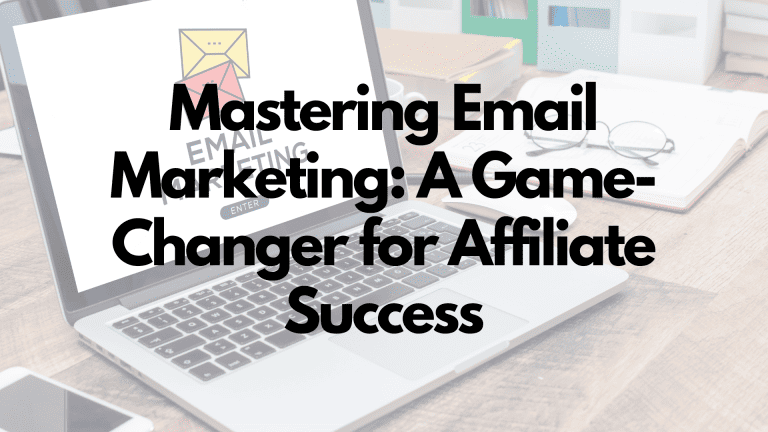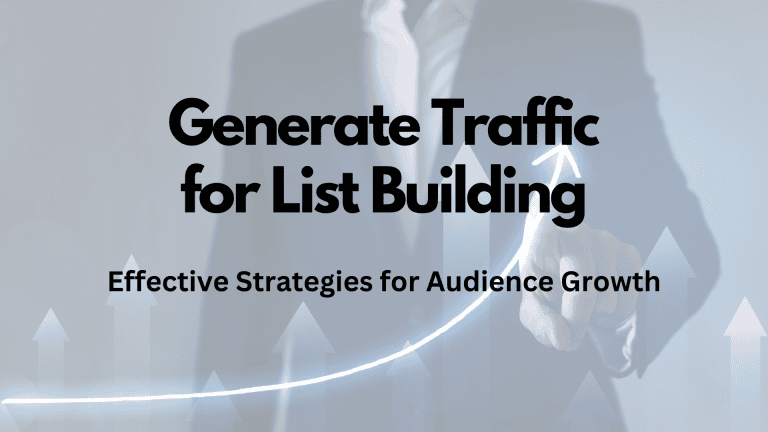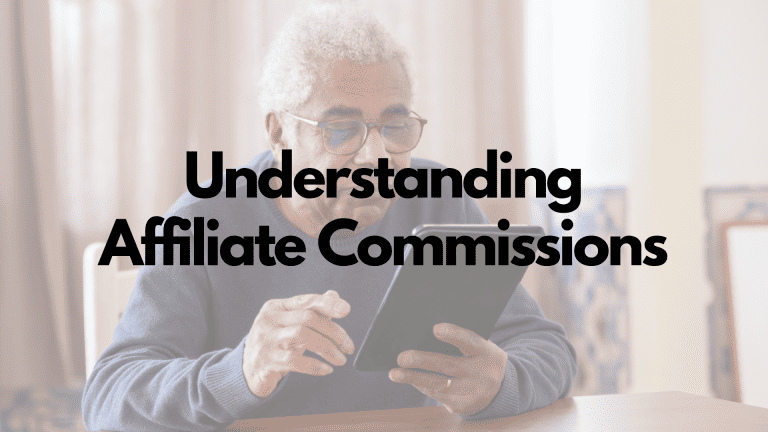
In the fast-paced world of digital marketing, email still reigns supreme. Despite social media and flashy trends, email marketing has stood the test of time.
Why?
Because it connects businesses directly with people. In an age where personalization is key, emails offer a unique way to engage with audiences on a personal level.
Now, imagine this powerhouse team-up: email marketing and affiliate success.
It's a match made in marketing heaven.
Email marketing becomes the secret weapon for affiliates, allowing them to send tailored messages and promotions directly to inboxes.
This direct approach builds trust and engagement. In the world of affiliate marketing, where connections matter most, mastering email marketing becomes a game-changer.
Together, they create a dynamic strategy that's not just complementary but essential for thriving in the vast digital landscape.
Get ready, because the fusion of email and affiliate marketing is the key to success in the ever-evolving online realm.
Why Email Marketing is Essential for Affiliates
One major reason why email marketing is a must-have for affiliates is the bang for your buck it delivers.
Compared to other marketing channels, email boasts an impressive return on investment (ROI).
Affiliates can stretch their marketing budget further as emails have a unique ability to reach a targeted audience directly.
Whether it's promoting products or sharing valuable content, the cost-effectiveness of email marketing makes it a no-brainer for affiliates looking to maximize their returns and get the most out of every marketing dollar.
Picture this: a potential customer opens their inbox to find a personalized email from an affiliate.
Email marketing allows affiliates to establish direct connections and speak directly to individuals.
This personalized touch goes a long way in building trust and loyalty. Unlike broader marketing approaches, emails can be tailored to suit the preferences and needs of each recipient.
By consistently delivering valuable content and promotions, affiliates can forge meaningful relationships with their audience, creating a sense of familiarity that is crucial for success in the competitive affiliate marketing landscape.
In essence, email marketing is the key to not just reaching potential customers but connecting with them on a personal level, making it an indispensable tool for affiliates aiming for long-term success.
Building Your Affiliate Email List
Growing your affiliate email list is like planting seeds for future success, and there are savvy strategies to make it flourish.
Lead magnets, such as free guides, exclusive discounts, or helpful resources, act like magnets for potential subscribers.
Offering these incentives in exchange for email sign-ups entices visitors to share their contact information.
Another effective technique is using compelling sign-up forms strategically placed on your website.
These forms should be easy to fill out and highlight the benefits of subscribing.
By employing these tactics, affiliates can steadily build a robust email list of engaged users who are genuinely interested in what they have to offer.
Once your email list starts to take shape, the next crucial step is targeting and segmentation.
Not all subscribers are the same, and treating them as such can lead to missed opportunities.
Targeting involves tailoring your content to specific groups based on factors like interests or purchasing behaviour.
Segmenting takes it a step further by dividing your list into smaller, more specific categories.
This personalized approach ensures that your audience receives content that resonates with them, increasing the likelihood of engagement and conversions.
Understanding the importance of targeting and segmenting transforms your email list from a generic audience to a dynamic group of individuals, each receiving content that speaks directly to their needs and preferences.
Building an email list can be made significantly more manageable with the help of powerful tools like OptinMonster and Sumo.
OptinMonster, for instance, offers customizable pop-ups and forms that can be strategically placed on your website to capture visitor information. Its user-friendly interface makes it easy to create eye-catching campaigns that convert.
Similarly, Sumo provides tools for list building, offering features like pop-ups, welcome mats, and smart bars.
These tools not only simplify the process of gathering email subscribers but also provide valuable insights into user behaviour.
Integrating these tools into your affiliate marketing strategy can supercharge your efforts, turning casual website visitors into dedicated subscribers and potential customers.
Crafting Compelling Email Content
When it comes to crafting emails that captivate your audience, think of it as creating a masterpiece with a few key elements.
Start with a compelling subject line that grabs attention.
The body of your email should be concise, yet impactful, delivering your message.
Incorporate visuals like images or graphics to enhance the visual appeal and break up text.
Ensure your content is relevant and provides value to your audience. Lastly, end with a strong call-to-action (CTA) that guides your subscribers towards the desired action, whether it's making a purchase or exploring more on your website.
This simple yet effective anatomy ensures that your affiliate emails are engaging and leave a lasting impression on your audience.
A successful affiliate email strikes the right balance between promotion and value. While it's important to showcase your affiliate products or services, bombarding your audience with constant promotions can lead to disengagement.
Integrate value-driven insights into your emails – share helpful tips, industry news, or exclusive content that aligns with your audience's interests.
By offering valuable information, you not only position yourself as an authority in your niche but also build trust with your subscribers.
This trust, in turn, makes them more receptive to your promotional content when it does appear, creating a harmonious blend that keeps your audience engaged and eager to open your emails.
The real magic happens when your subscribers not only read your emails but take the desired actions.
This is where persuasive Calls-to-Action (CTAs) come into play.
Your CTA should be clear, and compelling, and prompt readers to click through to your affiliate offers or website.
Use action-oriented language that creates a sense of urgency or excitement.
Experiment with different button colours or text styles to make your CTA visually stand out.
Whether it's “Shop Now,” “Learn More,” or “Claim Your Discount,” a well-crafted CTA acts as the guiding force that propels your subscribers toward conversion.
Don't underestimate the power of a persuasive CTA – it's the key to turning your engaging content into tangible results.
Personalization and Segmentation
In the world of email marketing, the idea of “one-size-fits-all” can be a bit misleading.
Generic emails sent to a broad audience often miss the mark.
People today crave personalized experiences, and generic messages can feel impersonal and irrelevant.
Tailoring your emails to suit individual preferences and behaviours is the key to capturing attention and fostering meaningful connections.
The modern email landscape demands a more nuanced approach, recognizing that each subscriber is unique and deserves content that resonates with their specific interests and needs.
Enter the power of segmentation – a game-changer in the quest for personalized communication.
Instead of treating your entire email list as one homogeneous group, segmentation involves categorizing subscribers based on shared characteristics.
This can include interests, demographics, purchase history, or engagement levels.
By segmenting your list, you can then create targeted campaigns that speak directly to the preferences of each subgroup.
For example, if you're an affiliate offering a range of products, segmenting your list allows you to send specific promotions to those who have previously shown interest in particular product categories.
This ensures that each subscriber receives content that aligns with their tastes, making your emails more relevant and increasing the likelihood of engagement.
To take your segmentation game to the next level, leverage advanced tools like Mailchimp and ConvertKit.
GetResponse offers robust segmentation features that allow you to create highly targeted campaigns.
You can segment based on customer behaviour, purchase history, and even demographic data.
ConvertKit, on the other hand, is known for its simplicity and effectiveness. It empowers users to create sophisticated automation sequences based on subscriber behaviour and interests.
These tools make the process of segmenting your email list more manageable and efficient, ensuring that your personalized messages reach the right audience at the right time.
With GetResponse and ConvertKit, personalization becomes not just a goal but a practical and achievable reality in your email marketing strategy.
Automating the Affiliate Email Journey
Enter the world of automated efficiency with drip campaigns and autoresponders.
Drip campaigns are a series of pre-scheduled emails that are sent automatically to subscribers over a set period.
These campaigns allow affiliates to create a personalized journey for their audience, delivering targeted content at strategic intervals.
Autoresponders, on the other hand, are automated emails triggered by specific actions, such as signing up for a newsletter or making a purchase.
Together, these tools streamline the affiliate email journey, ensuring that your subscribers receive timely and relevant content without requiring constant manual effort.
It's like having a personal assistant for your email marketing strategy, working tirelessly in the background to engage and nurture your audience.
Imagine a scenario where every new subscriber, cart abandoner, or recent customer receives a tailored series of emails without you having to lift a finger.
This is the beauty of setting up automated sequences.
For new subscribers, you can create a welcome series introducing them to your brand and offerings.
Cart abandoners can receive a gentle nudge to complete their purchase, and recent customers can be nurtured with post-purchase emails, exclusive offers, or related product recommendations.
These automated sequences not only save time but also ensure that each subscriber is guided through a personalized journey, increasing the chances of conversion and fostering a deeper connection with your brand.
To bring the magic of automation to life, consider incorporating tools found in GetResponse into your affiliate marketing arsenal.
GetResponse offers robust automation features, allowing you to create intricate workflows based on user behaviour, preferences, and engagement.
These tools enable you to set up targeted campaigns for various scenarios, ensuring that your subscribers receive the right message at the right time.
With GetResponse, you can elevate your affiliate email journey by automating the entire process, making it not only efficient but also highly effective in nurturing leads and driving conversions.
A/B Testing and Optimization
In the ever-evolving landscape of affiliate email marketing, refinement is the name of the game.
The journey doesn't end with sending out emails; it's a continuous process of improvement.
This iterative approach involves analyzing data, understanding subscriber behaviour, and making data-driven decisions to enhance the effectiveness of your email campaigns.
Optimization becomes a mindset, and with each campaign, affiliates embark on a journey of fine-tuning, adapting, and learning from the feedback received.
This commitment to continuous improvement is what separates successful email marketers from the rest, ensuring that each campaign builds on the lessons of the previous one.
Enter A/B testing, a powerful method for dissecting and improving your email campaigns.
A/B testing involves creating two versions (A and B) of an email and sending them to different segments of your audience.
By comparing the performance of these variations, affiliates can identify which elements resonate better with their audience.
Testing elements like subject lines, email copy, and calls-to-action (CTAs) can provide valuable insights into what encourages opens, clicks, and conversions.
For instance, does a playful subject line work better than a straightforward one? Is a concise CTA more effective than a detailed one?
A/B testing answers these questions, helping affiliates make informed decisions and refine their campaigns based on real audience preferences.
To dive into the world of A/B testing, affiliates can leverage tools found in GetResponse.
These platforms offer intuitive A/B testing features, allowing you to experiment with different email variations and measure their performance.
Understanding the results of your A/B tests is equally important. Analytics tools provided by these platforms offer insights into open rates, click-through rates, and conversion metrics.
By interpreting these results, affiliates can make informed decisions on what tweaks are needed for future campaigns.
A/B testing, combined with robust analytics, not only refines your current campaign but equips you with the knowledge to continually optimize and elevate your affiliate email marketing strategy.
Ensuring Compliance and Building Trust
In the realm of affiliate email marketing, trust is non-negotiable, and compliance plays a crucial role.
The General Data Protection Regulation (GDPR) and the Controlling the Assault of Non-Solicited Pornography And Marketing (CAN-SPAM) Act are two regulatory frameworks that demand attention.
GDPR, applicable to EU residents, emphasizes the importance of obtaining explicit consent before sending marketing emails, ensuring transparency in data handling, and providing individuals with the right to control their personal information.
Similarly, the CAN-SPAM Act focuses on regulating commercial emails by requiring clear opt-out options, accurate sender information, and avoidance of deceptive subject lines.
Adhering to these regulations not only keeps your affiliate marketing efforts on the right side of the law but also builds a foundation of trust with your subscribers, showing them that their privacy is a top priority.
Trust is a delicate asset in the world of email marketing, and transparency is its currency.
When engaging in affiliate marketing, it's essential to maintain transparency by clearly disclosing your affiliation in your emails.
Be upfront about your relationship with the products or services you promote.
Avoiding spammy tactics, such as deceptive subject lines or excessive use of exclamation marks, is equally crucial.
Subscribers appreciate honesty and authenticity.
By steering clear of manipulative strategies, you not only comply with regulations but also cultivate trust with your audience.
Building trust is a continuous effort, and consistently providing valuable, transparent content in your emails ensures that subscribers view you as a reliable source rather than just another marketer.
Trust is not a one-time achievement but an ongoing relationship.
To build and maintain trust with your email subscribers, focus on delivering value.
Provide content that genuinely benefits your audience, whether it's informative articles, exclusive offers, or personalized recommendations.
Consistency is key – set expectations for the frequency and type of content you deliver and stick to them.
Engage with your audience by encouraging feedback, responding to inquiries promptly, and being receptive to their preferences.
By demonstrating a genuine commitment to their needs and respecting their privacy, you foster a sense of trust that goes beyond individual emails, laying the groundwork for a lasting and fruitful relationship with your subscribers.
Analyzing and Measuring Email Campaign Success
Unlocking the effectiveness of your affiliate email campaigns relies heavily on understanding key metrics.
Open rates, indicating the percentage of recipients who open your emails, provide insights into the initial engagement.
Click-through rates reveal how many recipients interact with the content by clicking on links, showcasing the level of interest generated.
Finally, conversion rates, the percentage of subscribers who complete the desired action, be it making a purchase or signing up, gauge the ultimate success of your campaign.
These metrics serve as your compass, guiding you in evaluating the impact of your emails and helping you tailor future campaigns to better resonate with your audience.
To delve into the nitty-gritty of your email campaign performance, consider harnessing the power of analytics tools such as HubSpot and SendinBlue.
These platforms provide in-depth insights beyond basic metrics. HubSpot, for instance, offers detailed analytics on user behaviour, helping you understand how recipients engage with your content over time.
Leveraging these tools allows you to move beyond surface-level statistics, gaining a deeper understanding of what resonates with your audience and refining your strategies accordingly.
The real magic in email marketing happens when you use performance insights to adjust and optimize your strategies.
If a particular subject line results in higher open rates, replicate that success in future campaigns. Identify the types of content that drive clicks and conversions, then tailor your content strategy accordingly.
Tools like HubSpot not only present you with data but empower you to act on it.
Whether it's tweaking your messaging, refining your segmentation, or adjusting the timing of your campaigns, the ability to adapt based on performance insights ensures that your affiliate email marketing strategy remains dynamic and effective in the ever-changing landscape of digital communication.
Conclusion To Mastering Email Marketing
In the ever-evolving landscape of digital marketing, where trends come and go, email marketing stands as an enduring force, and its union with affiliate success is nothing short of extraordinary.
Through our exploration of the dynamic interplay between email marketing and affiliate strategies, it becomes evident that this combination is more than just a partnership – it's a game-changer.
Email marketing, with its personal touch and direct connection, emerges as the secret weapon that affiliates wield to engage, nurture, and ultimately thrive in the vast digital landscape.
The unparalleled potential of email marketing in the affiliate realm lies not only in its cost-effectiveness and impressive ROI but also in its ability to build trust, foster connections, and provide personalized experiences.
It's a tool that transcends the digital noise, enabling affiliates to create meaningful relationships with their audience.
As we conclude this exploration, the message is clear: mastering email marketing is not merely an option; it's an essential strategy for those aiming to carve a successful path in the competitive world of affiliate marketing.
Recognizing that the only constant is change, the strategies and tactics that work today may evolve tomorrow.
Therefore, the journey doesn't end here; it's an ongoing exploration.
Embrace continuous learning, stay abreast of industry trends, and adapt your email strategies accordingly.
The magic lies in the ability to evolve, refine, and optimize your approach based on insights and emerging best practices.
As an affiliate marketer, your commitment to staying agile and learning from every campaign will be the driving force behind your sustained success.
Kickstart or Refine Your Affiliate Email Marketing Journey
Ready to unleash the full potential of email marketing in your affiliate endeavours?
Whether you're just starting or looking to refine your existing strategies, now is the time to take action.
Dive into the world of personalized connections, automated efficiency, and strategic refinement.
Explore the tools mentioned, experiment with compelling content, and start building those crucial relationships with your audience.
Your journey to affiliate success through email marketing is just a step away.
We invite you to share your experiences, insights, and questions in the comments section below.
What challenges have you faced in your affiliate email marketing journey?
What strategies have proven successful for you?
Let's create a space for collaboration and knowledge-sharing.
Your input not only enriches the community but also contributes to the collective growth of affiliate marketers navigating the exciting landscape of email marketing.
Together, let's continue the conversation and propel each other toward unparalleled success in the affiliate realm!






